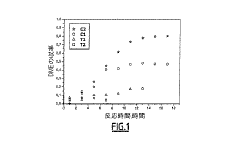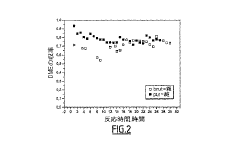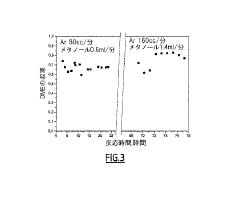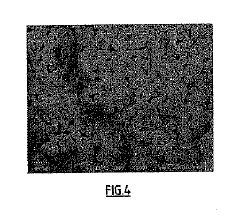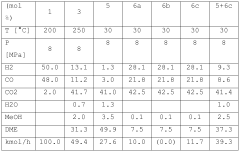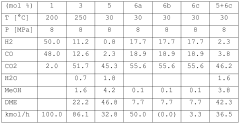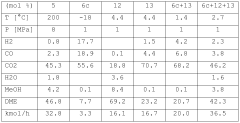Building Competence for Dimethyl Ether Industrial Revolutions
JUL 1, 20259 MIN READ
Generate Your Research Report Instantly with AI Agent
Patsnap Eureka helps you evaluate technical feasibility & market potential.
DME Tech Background
Dimethyl ether (DME) has emerged as a promising alternative fuel and chemical feedstock, gaining significant attention in recent decades. This clean-burning, non-toxic compound is derived from various sources, including natural gas, coal, and biomass, positioning it as a versatile player in the energy transition landscape.
The journey of DME began in the early 20th century when it was first synthesized, but its potential as a fuel and chemical intermediate was not fully recognized until the late 1990s. Since then, research and development efforts have intensified, driven by the global push for cleaner energy solutions and the need to reduce dependence on traditional fossil fuels.
DME's unique properties make it an attractive option for multiple applications. It can be used as a substitute for liquefied petroleum gas (LPG), a diesel fuel alternative, and a precursor in the production of various chemicals. Its low emissions profile, particularly in terms of particulate matter and NOx, aligns well with increasingly stringent environmental regulations worldwide.
The technology for DME production has evolved significantly over the years. Initially, DME was primarily produced as a byproduct of methanol synthesis. However, advancements in catalytic processes have led to more efficient direct synthesis methods, improving overall production economics and scalability.
Global interest in DME has been growing steadily, with several countries investing in research, pilot projects, and commercial-scale production facilities. China, in particular, has been at the forefront of DME adoption, driven by its abundant coal resources and the need for cleaner fuel alternatives. Japan and Sweden have also made significant strides in DME technology development and application.
As the world grapples with climate change and energy security concerns, DME is poised to play a crucial role in the industrial revolutions of the future. Its potential to contribute to decarbonization efforts across various sectors, from transportation to power generation and chemical manufacturing, underscores the importance of building competence in DME technology.
The path forward for DME involves addressing several key challenges, including optimizing production processes, developing dedicated infrastructure, and expanding market acceptance. Ongoing research focuses on improving catalyst efficiency, exploring new feedstock options, and enhancing the overall sustainability of DME production and utilization.
The journey of DME began in the early 20th century when it was first synthesized, but its potential as a fuel and chemical intermediate was not fully recognized until the late 1990s. Since then, research and development efforts have intensified, driven by the global push for cleaner energy solutions and the need to reduce dependence on traditional fossil fuels.
DME's unique properties make it an attractive option for multiple applications. It can be used as a substitute for liquefied petroleum gas (LPG), a diesel fuel alternative, and a precursor in the production of various chemicals. Its low emissions profile, particularly in terms of particulate matter and NOx, aligns well with increasingly stringent environmental regulations worldwide.
The technology for DME production has evolved significantly over the years. Initially, DME was primarily produced as a byproduct of methanol synthesis. However, advancements in catalytic processes have led to more efficient direct synthesis methods, improving overall production economics and scalability.
Global interest in DME has been growing steadily, with several countries investing in research, pilot projects, and commercial-scale production facilities. China, in particular, has been at the forefront of DME adoption, driven by its abundant coal resources and the need for cleaner fuel alternatives. Japan and Sweden have also made significant strides in DME technology development and application.
As the world grapples with climate change and energy security concerns, DME is poised to play a crucial role in the industrial revolutions of the future. Its potential to contribute to decarbonization efforts across various sectors, from transportation to power generation and chemical manufacturing, underscores the importance of building competence in DME technology.
The path forward for DME involves addressing several key challenges, including optimizing production processes, developing dedicated infrastructure, and expanding market acceptance. Ongoing research focuses on improving catalyst efficiency, exploring new feedstock options, and enhancing the overall sustainability of DME production and utilization.
DME Market Analysis
The global dimethyl ether (DME) market has been experiencing significant growth in recent years, driven by increasing demand for clean-burning alternative fuels and the expanding applications of DME in various industries. As a versatile compound, DME is gaining traction in both energy and chemical sectors, positioning itself as a key player in the industrial revolution towards sustainable and environmentally friendly solutions.
The market demand for DME is primarily fueled by its potential as a substitute for conventional fossil fuels, particularly in the transportation and power generation sectors. DME's properties as a clean-burning fuel with low emissions make it an attractive option for reducing greenhouse gas emissions and meeting stringent environmental regulations. This has led to a surge in research and development activities aimed at optimizing DME production processes and expanding its applications.
In the energy sector, DME is increasingly being considered as a viable alternative to liquefied petroleum gas (LPG) and diesel fuel. Its compatibility with existing LPG infrastructure and its potential to be used in modified diesel engines have opened up new market opportunities. The power generation industry is also exploring DME as a fuel for gas turbines, offering a cleaner alternative to natural gas and other fossil fuels.
The chemical industry represents another significant market for DME, where it serves as a crucial intermediate in the production of various chemicals and materials. DME is used in the manufacture of aerosol propellants, solvents, and as a raw material for producing dimethyl sulfate and acetic acid. This diversification of applications has contributed to the steady growth of the DME market and its increasing importance in industrial processes.
Geographically, the Asia-Pacific region dominates the global DME market, with China leading in both production and consumption. The region's rapid industrialization, coupled with government initiatives to promote clean energy alternatives, has been a major driver for DME adoption. Europe and North America are also witnessing growing interest in DME, particularly in the context of renewable energy policies and the push for sustainable transportation solutions.
The market landscape is characterized by a mix of established chemical companies and emerging players specializing in DME production. Collaborations between technology providers, fuel producers, and end-users are becoming more common, aiming to accelerate the commercialization of DME technologies and expand market reach. These partnerships are crucial for overcoming technical challenges and scaling up production to meet the growing demand.
The market demand for DME is primarily fueled by its potential as a substitute for conventional fossil fuels, particularly in the transportation and power generation sectors. DME's properties as a clean-burning fuel with low emissions make it an attractive option for reducing greenhouse gas emissions and meeting stringent environmental regulations. This has led to a surge in research and development activities aimed at optimizing DME production processes and expanding its applications.
In the energy sector, DME is increasingly being considered as a viable alternative to liquefied petroleum gas (LPG) and diesel fuel. Its compatibility with existing LPG infrastructure and its potential to be used in modified diesel engines have opened up new market opportunities. The power generation industry is also exploring DME as a fuel for gas turbines, offering a cleaner alternative to natural gas and other fossil fuels.
The chemical industry represents another significant market for DME, where it serves as a crucial intermediate in the production of various chemicals and materials. DME is used in the manufacture of aerosol propellants, solvents, and as a raw material for producing dimethyl sulfate and acetic acid. This diversification of applications has contributed to the steady growth of the DME market and its increasing importance in industrial processes.
Geographically, the Asia-Pacific region dominates the global DME market, with China leading in both production and consumption. The region's rapid industrialization, coupled with government initiatives to promote clean energy alternatives, has been a major driver for DME adoption. Europe and North America are also witnessing growing interest in DME, particularly in the context of renewable energy policies and the push for sustainable transportation solutions.
The market landscape is characterized by a mix of established chemical companies and emerging players specializing in DME production. Collaborations between technology providers, fuel producers, and end-users are becoming more common, aiming to accelerate the commercialization of DME technologies and expand market reach. These partnerships are crucial for overcoming technical challenges and scaling up production to meet the growing demand.
DME Tech Challenges
The development of dimethyl ether (DME) as an industrial fuel faces several significant technical challenges that need to be addressed for its widespread adoption. One of the primary obstacles is the optimization of DME production processes. Current methods, such as dehydration of methanol or direct synthesis from syngas, still require improvements in efficiency and cost-effectiveness. Enhancing catalyst performance and longevity is crucial for increasing yield and reducing production costs.
Another major challenge lies in the storage and transportation of DME. Due to its low boiling point and high vapor pressure, DME requires specialized handling and infrastructure. Developing advanced storage solutions, such as composite materials for tanks and improved sealing technologies, is essential for safe and efficient DME distribution. Additionally, retrofitting existing LPG infrastructure for DME compatibility presents both technical and economic hurdles.
The adaptation of engines and fuel systems for DME use is a critical area requiring further research and development. While DME has shown promise as a diesel substitute, modifications to fuel injection systems, seals, and lubricants are necessary to accommodate its unique properties. Optimizing combustion characteristics and emissions control for DME-powered engines remains an ongoing challenge, particularly in meeting stringent environmental regulations.
Material compatibility is another significant issue in DME technology. The solvent properties of DME can cause degradation of certain plastics and elastomers commonly used in fuel systems. Identifying and developing DME-resistant materials for seals, gaskets, and other components is crucial for ensuring the long-term reliability of DME-fueled equipment.
Furthermore, the purification of DME to meet fuel-grade standards presents technical difficulties. Removing impurities, particularly water and methanol, to achieve the required purity levels for various applications is a complex process that demands innovative separation techniques and quality control measures.
Scaling up DME production to industrial levels while maintaining economic viability is a multifaceted challenge. It involves optimizing process integration, heat recovery, and overall plant efficiency. The development of modular and flexible production units capable of adapting to various feedstocks and market demands is an area of ongoing research.
Lastly, the integration of DME production with renewable energy sources and carbon capture technologies presents both opportunities and challenges. Developing efficient processes for producing green DME from biomass or captured CO2 is crucial for enhancing its environmental credentials and long-term sustainability in the face of climate change concerns.
Another major challenge lies in the storage and transportation of DME. Due to its low boiling point and high vapor pressure, DME requires specialized handling and infrastructure. Developing advanced storage solutions, such as composite materials for tanks and improved sealing technologies, is essential for safe and efficient DME distribution. Additionally, retrofitting existing LPG infrastructure for DME compatibility presents both technical and economic hurdles.
The adaptation of engines and fuel systems for DME use is a critical area requiring further research and development. While DME has shown promise as a diesel substitute, modifications to fuel injection systems, seals, and lubricants are necessary to accommodate its unique properties. Optimizing combustion characteristics and emissions control for DME-powered engines remains an ongoing challenge, particularly in meeting stringent environmental regulations.
Material compatibility is another significant issue in DME technology. The solvent properties of DME can cause degradation of certain plastics and elastomers commonly used in fuel systems. Identifying and developing DME-resistant materials for seals, gaskets, and other components is crucial for ensuring the long-term reliability of DME-fueled equipment.
Furthermore, the purification of DME to meet fuel-grade standards presents technical difficulties. Removing impurities, particularly water and methanol, to achieve the required purity levels for various applications is a complex process that demands innovative separation techniques and quality control measures.
Scaling up DME production to industrial levels while maintaining economic viability is a multifaceted challenge. It involves optimizing process integration, heat recovery, and overall plant efficiency. The development of modular and flexible production units capable of adapting to various feedstocks and market demands is an area of ongoing research.
Lastly, the integration of DME production with renewable energy sources and carbon capture technologies presents both opportunities and challenges. Developing efficient processes for producing green DME from biomass or captured CO2 is crucial for enhancing its environmental credentials and long-term sustainability in the face of climate change concerns.
Current DME Solutions
01 Production of dimethyl ether
Various methods for producing dimethyl ether are described, including catalytic dehydration of methanol, direct synthesis from syngas, and conversion of other hydrocarbons. These processes often involve specific catalysts and reaction conditions to optimize yield and selectivity.- Production of dimethyl ether: Various methods for producing dimethyl ether are described, including catalytic dehydration of methanol, direct synthesis from syngas, and conversion of other hydrocarbons. These processes often involve specific catalysts and reaction conditions to optimize yield and selectivity.
- Catalysts for dimethyl ether synthesis: Different types of catalysts are used in the production of dimethyl ether, including zeolites, metal oxides, and composite catalysts. The choice of catalyst can significantly affect the reaction efficiency, product selectivity, and overall process economics.
- Applications of dimethyl ether: Dimethyl ether has various applications, including use as a fuel substitute, aerosol propellant, and chemical intermediate. Its properties make it suitable for use in diesel engines, household products, and as a feedstock for other chemical processes.
- Purification and separation of dimethyl ether: Methods for purifying and separating dimethyl ether from reaction mixtures or other compounds are described. These processes may involve distillation, adsorption, or membrane separation techniques to achieve high-purity dimethyl ether for various applications.
- Environmental and safety considerations: Research on the environmental impact and safety aspects of dimethyl ether production and use is ongoing. This includes studies on emissions reduction, handling procedures, and potential hazards associated with its storage and transportation.
02 Catalysts for dimethyl ether synthesis
Different types of catalysts are used in the production of dimethyl ether, including zeolites, metal oxides, and composite catalysts. The choice and preparation of catalysts significantly influence the efficiency and selectivity of the dimethyl ether synthesis process.Expand Specific Solutions03 Applications of dimethyl ether
Dimethyl ether has various applications, including use as a fuel additive, aerosol propellant, and refrigerant. It is also being explored as an alternative clean fuel for diesel engines and power generation due to its favorable combustion properties.Expand Specific Solutions04 Purification and separation of dimethyl ether
Methods for purifying and separating dimethyl ether from reaction mixtures or other compounds are described. These processes often involve distillation, adsorption, or membrane separation techniques to obtain high-purity dimethyl ether.Expand Specific Solutions05 Environmental and safety considerations
Research on the environmental impact and safety aspects of dimethyl ether production and use is ongoing. This includes studies on emissions reduction, storage safety, and handling procedures to ensure the sustainable and safe utilization of dimethyl ether in various applications.Expand Specific Solutions
DME Industry Players
The competitive landscape for building competence in Dimethyl Ether (DME) industrial revolutions is characterized by a mature market with significant growth potential. The global DME market is in a growth phase, driven by increasing demand for clean energy alternatives and stringent environmental regulations. Major players include established petrochemical companies like China Petroleum & Chemical Corp., SK Energy, and Haldor Topsøe, alongside research institutions such as Fraunhofer-Gesellschaft and CSIC. These organizations are investing heavily in R&D to improve DME production efficiency and expand its applications. The technology's maturity varies, with some companies like Sinopec and Air Liquide having advanced commercial-scale production capabilities, while others are still in the developmental stages, indicating a dynamic and competitive environment for innovation in this sector.
China Petroleum & Chemical Corp.
Technical Solution: China Petroleum & Chemical Corp. (Sinopec) has developed a proprietary DME production technology using coal as feedstock. Their process involves coal gasification, methanol synthesis, and methanol dehydration to produce DME. The company has implemented large-scale DME production facilities with capacities exceeding 1 million tons per year[1]. Sinopec's technology achieves high carbon conversion rates of up to 55% and overall energy efficiency of around 45%[2]. They have also developed catalysts that improve DME yield and selectivity, with reported methanol conversion rates of over 80%[3].
Strengths: Vast experience in large-scale DME production, proprietary catalyst technology, and integrated supply chain. Weaknesses: Heavy reliance on coal feedstock may face environmental challenges in the long term.
Haldor Topsøe A/S
Technical Solution: Haldor Topsøe has developed an innovative one-step DME synthesis process called TIGAS (Topsøe Improved Gasoline Synthesis). This technology combines syngas production, methanol synthesis, and DME synthesis in a single reactor, significantly reducing capital and operating costs[4]. The process can use various feedstocks, including natural gas, coal, and biomass. Topsøe's catalysts achieve high selectivity towards DME, with reported yields of up to 55% per pass[5]. The company has also developed a novel DME-to-gasoline process, expanding the potential applications of DME as a fuel intermediate[6].
Strengths: Efficient one-step synthesis process, flexible feedstock options, and advanced catalyst technology. Weaknesses: Limited commercial-scale implementations compared to some competitors.
Key DME Innovations
Dehydration of methanol to dimethyl ether using a catalyst based on zeolites supported on silicon carbide.
PatentInactiveJP2010511680A
Innovation
- Immobilizing zeolites on silicon carbide (SiC) supports with high specific surface areas, which enhances catalyst stability by rapid heat dissipation and reduces coking, maintaining activity for extended periods.
Process for the preparation of dimethyl ether
PatentWO2014032973A1
Innovation
- A process involving catalytic conversion of synthesis gas to dimethyl ether, followed by cooling and separation into liquid and gaseous phases, with the liquid phase being treated in a scrubbing zone using a potassium carbonate or amine-based solvent to absorb carbon dioxide, while depressurizing and separating the phases to reduce carbon monoxide concentration and prevent solvent degradation.
DME Policy Landscape
The policy landscape for dimethyl ether (DME) has been evolving rapidly in recent years, reflecting the growing recognition of DME's potential as a clean and versatile alternative fuel. Governments worldwide are implementing supportive policies to promote DME production and utilization, aiming to reduce greenhouse gas emissions and enhance energy security.
In the United States, the Environmental Protection Agency (EPA) has approved DME as a renewable fuel under the Renewable Fuel Standard (RFS) program. This designation allows DME producers to generate Renewable Identification Numbers (RINs), providing economic incentives for DME production from renewable sources. Additionally, several states have included DME in their low-carbon fuel standards, further encouraging its adoption in the transportation sector.
The European Union has also taken significant steps to support DME development. The Renewable Energy Directive (RED II) recognizes DME as an advanced biofuel, setting targets for its use in the transportation sector. This policy framework has spurred investment in DME production facilities and infrastructure across Europe.
In Asia, China has emerged as a leader in DME policy support. The Chinese government has implemented a series of policies to promote DME as a clean cooking fuel and industrial feedstock. These include subsidies for DME production facilities, tax incentives for DME use, and mandates for DME blending in certain regions. Japan and South Korea have also introduced policies to support DME research and development, focusing on its potential as a hydrogen carrier and power generation fuel.
Developing countries, particularly in Southeast Asia and Africa, are increasingly recognizing DME's potential to address energy access issues. Several nations have implemented pilot programs to introduce DME as a cleaner alternative to traditional biomass and kerosene for cooking and heating.
International organizations are playing a crucial role in shaping the global DME policy landscape. The International Energy Agency (IEA) has highlighted DME as a key technology for decarbonizing the transport and industrial sectors. The United Nations' Sustainable Energy for All (SE4All) initiative has also recognized DME's potential to contribute to universal energy access goals.
Despite these positive developments, challenges remain in the DME policy landscape. Harmonization of standards and regulations across different regions is needed to facilitate global trade and technology transfer. Additionally, more comprehensive life-cycle assessments are required to fully understand and quantify the environmental benefits of DME across various production pathways and end-use applications.
In the United States, the Environmental Protection Agency (EPA) has approved DME as a renewable fuel under the Renewable Fuel Standard (RFS) program. This designation allows DME producers to generate Renewable Identification Numbers (RINs), providing economic incentives for DME production from renewable sources. Additionally, several states have included DME in their low-carbon fuel standards, further encouraging its adoption in the transportation sector.
The European Union has also taken significant steps to support DME development. The Renewable Energy Directive (RED II) recognizes DME as an advanced biofuel, setting targets for its use in the transportation sector. This policy framework has spurred investment in DME production facilities and infrastructure across Europe.
In Asia, China has emerged as a leader in DME policy support. The Chinese government has implemented a series of policies to promote DME as a clean cooking fuel and industrial feedstock. These include subsidies for DME production facilities, tax incentives for DME use, and mandates for DME blending in certain regions. Japan and South Korea have also introduced policies to support DME research and development, focusing on its potential as a hydrogen carrier and power generation fuel.
Developing countries, particularly in Southeast Asia and Africa, are increasingly recognizing DME's potential to address energy access issues. Several nations have implemented pilot programs to introduce DME as a cleaner alternative to traditional biomass and kerosene for cooking and heating.
International organizations are playing a crucial role in shaping the global DME policy landscape. The International Energy Agency (IEA) has highlighted DME as a key technology for decarbonizing the transport and industrial sectors. The United Nations' Sustainable Energy for All (SE4All) initiative has also recognized DME's potential to contribute to universal energy access goals.
Despite these positive developments, challenges remain in the DME policy landscape. Harmonization of standards and regulations across different regions is needed to facilitate global trade and technology transfer. Additionally, more comprehensive life-cycle assessments are required to fully understand and quantify the environmental benefits of DME across various production pathways and end-use applications.
DME Environmental Impact
Dimethyl ether (DME) has gained significant attention as a promising alternative fuel due to its potential environmental benefits. As the industrial revolution surrounding DME continues to evolve, it is crucial to assess its environmental impact comprehensively. DME production and utilization offer several advantages in terms of reduced emissions and improved air quality compared to conventional fossil fuels.
One of the primary environmental benefits of DME is its clean-burning properties. When used as a fuel in compression ignition engines, DME produces significantly lower particulate matter emissions compared to diesel fuel. This reduction in particulate matter can lead to improved air quality, particularly in urban areas where vehicle emissions are a major concern. Additionally, DME combustion results in lower nitrogen oxide (NOx) emissions, further contributing to reduced air pollution and potential health benefits for populations in areas with high traffic density.
From a greenhouse gas perspective, DME production and use can potentially contribute to climate change mitigation efforts. When produced from renewable sources such as biomass or captured carbon dioxide, DME can have a significantly lower carbon footprint compared to conventional fossil fuels. The lifecycle greenhouse gas emissions of DME depend on the feedstock and production process used, but studies have shown that renewable DME can achieve substantial reductions in carbon dioxide emissions compared to petroleum-based fuels.
Water pollution is another important aspect to consider in the environmental impact assessment of DME. The production process for DME typically involves fewer water-intensive steps compared to some other alternative fuels, potentially reducing the strain on water resources. However, proper wastewater management practices must be implemented to minimize any potential negative impacts on local water bodies and ecosystems.
Land use changes associated with DME production, particularly when derived from biomass feedstocks, require careful consideration. While the use of agricultural residues or waste materials for DME production can provide a sustainable pathway, large-scale cultivation of dedicated energy crops for DME feedstock may lead to competition with food production or result in deforestation if not managed properly. Sustainable land management practices and careful selection of feedstock sources are essential to mitigate potential negative impacts on biodiversity and ecosystem services.
The environmental impact of DME extends beyond its production and use phases. The development of DME infrastructure, including storage and distribution systems, must be designed with environmental considerations in mind. Proper handling and storage practices are necessary to prevent leaks or spills that could potentially harm soil or water resources. Additionally, the end-of-life management of DME-related equipment and infrastructure should be considered to ensure proper recycling or disposal methods are employed.
One of the primary environmental benefits of DME is its clean-burning properties. When used as a fuel in compression ignition engines, DME produces significantly lower particulate matter emissions compared to diesel fuel. This reduction in particulate matter can lead to improved air quality, particularly in urban areas where vehicle emissions are a major concern. Additionally, DME combustion results in lower nitrogen oxide (NOx) emissions, further contributing to reduced air pollution and potential health benefits for populations in areas with high traffic density.
From a greenhouse gas perspective, DME production and use can potentially contribute to climate change mitigation efforts. When produced from renewable sources such as biomass or captured carbon dioxide, DME can have a significantly lower carbon footprint compared to conventional fossil fuels. The lifecycle greenhouse gas emissions of DME depend on the feedstock and production process used, but studies have shown that renewable DME can achieve substantial reductions in carbon dioxide emissions compared to petroleum-based fuels.
Water pollution is another important aspect to consider in the environmental impact assessment of DME. The production process for DME typically involves fewer water-intensive steps compared to some other alternative fuels, potentially reducing the strain on water resources. However, proper wastewater management practices must be implemented to minimize any potential negative impacts on local water bodies and ecosystems.
Land use changes associated with DME production, particularly when derived from biomass feedstocks, require careful consideration. While the use of agricultural residues or waste materials for DME production can provide a sustainable pathway, large-scale cultivation of dedicated energy crops for DME feedstock may lead to competition with food production or result in deforestation if not managed properly. Sustainable land management practices and careful selection of feedstock sources are essential to mitigate potential negative impacts on biodiversity and ecosystem services.
The environmental impact of DME extends beyond its production and use phases. The development of DME infrastructure, including storage and distribution systems, must be designed with environmental considerations in mind. Proper handling and storage practices are necessary to prevent leaks or spills that could potentially harm soil or water resources. Additionally, the end-of-life management of DME-related equipment and infrastructure should be considered to ensure proper recycling or disposal methods are employed.
Unlock deeper insights with Patsnap Eureka Quick Research — get a full tech report to explore trends and direct your research. Try now!
Generate Your Research Report Instantly with AI Agent
Supercharge your innovation with Patsnap Eureka AI Agent Platform!
